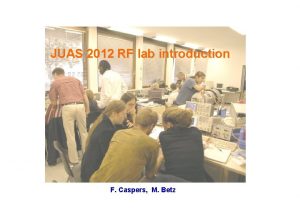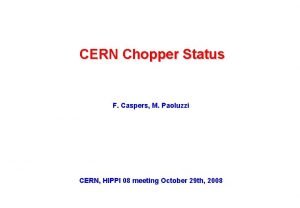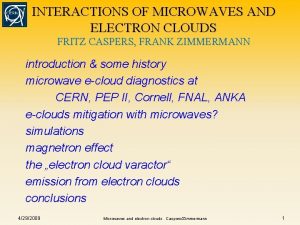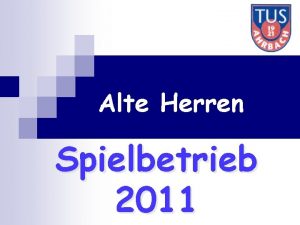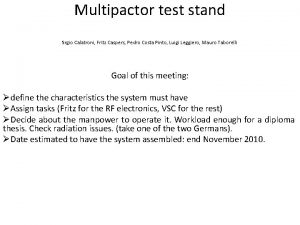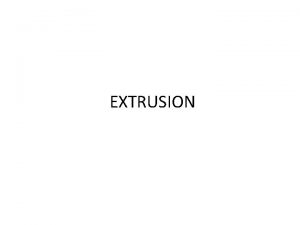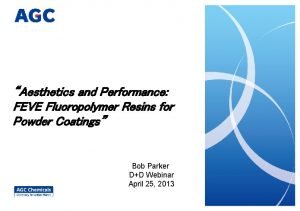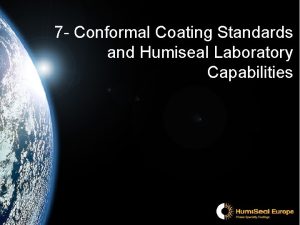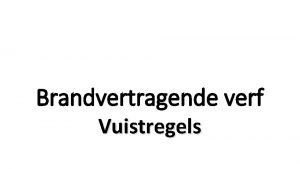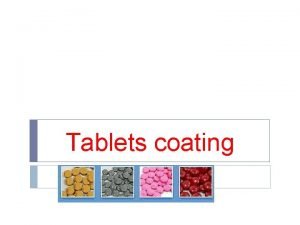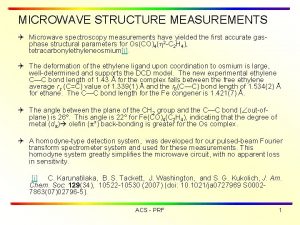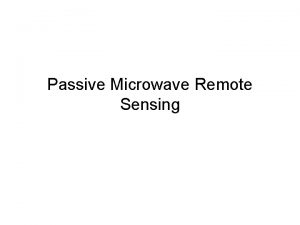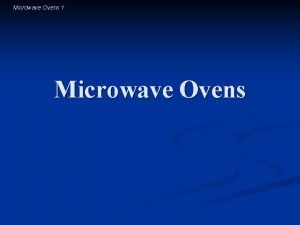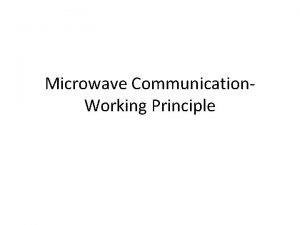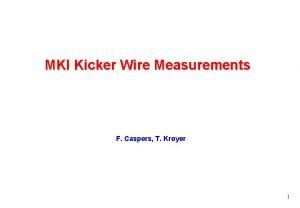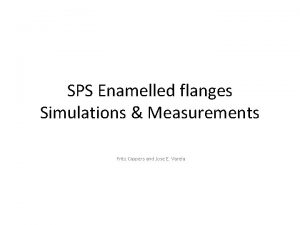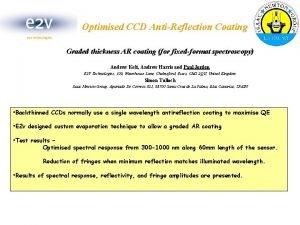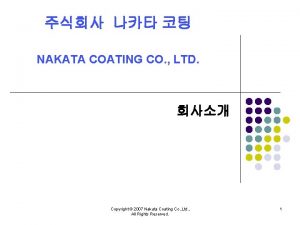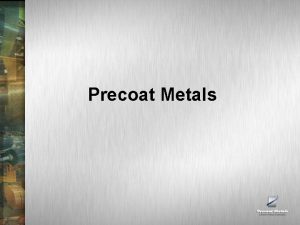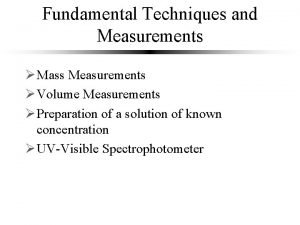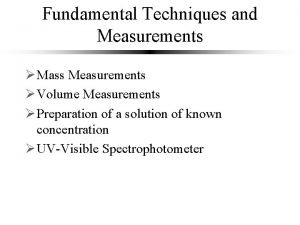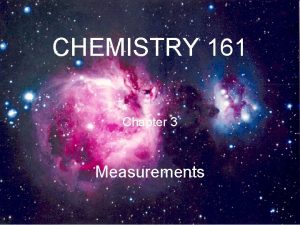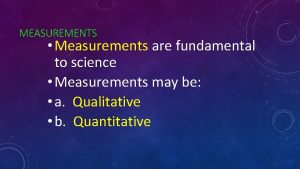Diagnostic of Coating Results Microwave Measurements F Caspers






![AM Modulation where: AC…. constant determining overall signal amplitude a ……modulation index [0≤|a|≤ 1] AM Modulation where: AC…. constant determining overall signal amplitude a ……modulation index [0≤|a|≤ 1]](https://slidetodoc.com/presentation_image_h2/e138047773b9c1a6ee962d4747a35368/image-7.jpg)




















- Slides: 27

Diagnostic of Coating Results: Microwave Measurements F. Caspers, S. Federmann, E. Mahner, B. Salvant, D. Seebacher 1

Contents �Introduction � Ecloud and coating � Measurement possibilities � Modulation of signals �Realisation of the experiment � Problems and Solutions �Latest results and preliminary conclusions �Summary and outlook 2

Introduction �High intensity beams may build up ecloud �Undesired effect Ø Reduces luminosity, beam stability �Mitigation: Coating of beampipe Ø reduction/supression of ecloud expected �testing required 3

Measurement Configurations �Pick up electrodes to monitor ecloud (talk by C. Yin Vallgren) Ø Local measurement only �Pressure measurements (talk by M. Taborelli) �Measurement of phase modulation of a microwave (MW) signal due to ecloud 4

MW Transmission Measurements Theory �Measurement of phase modulation (PM) of MW signal could give information of integrated ecloud density: wp…. Plasma frequency w……Injected frequency (f = 2. 68 GHz) wc…. Cutoff frequency (f = 1. 23 GHz) L……length of transmission path (6. 5 m) �Δφ is proportional to the electron cloud density: ne …typical electron cloud density ≈ 1012 �Expect a phase shift of Δφ = 2. 3 10 -3 rad (order of magnitude) 5

Modulation �Consider a continuous, pure sinusoidal wave (CW): Amplitude Modulation Phase Modulation 6
![AM Modulation where AC constant determining overall signal amplitude a modulation index 0a 1 AM Modulation where: AC…. constant determining overall signal amplitude a ……modulation index [0≤|a|≤ 1]](https://slidetodoc.com/presentation_image_h2/e138047773b9c1a6ee962d4747a35368/image-7.jpg)
AM Modulation where: AC…. constant determining overall signal amplitude a ……modulation index [0≤|a|≤ 1] m(t). . . normalized modulation signal ωC…. . frequency of carrier If: Taken from: R. Witte, Spectrum and Network Measurements, 1991 7

AM Modulation Time domain: Frequency domain: ωC - ωm ωC ωC + ωm ω Result in time domain 8

PM Modulation In case of sinusoidal (and narrowband) modulation: 180° Phase shift! β. . modulation index 9

PM Modulation Time domain: Frequency domain: (narrowband FM) ωC - ωm ωC ωC + ωm ω Result in time domain 10

Modulation �Combination of modulation: Unequal height of sidebands! This is the practical situation in SPS MW experiment (BA 5) and we have to separate the undesired AM signal from the desired PM signal by suitable instruments of the Vector Spectrum Analyzer (VSA) 11

Experimental Realisation �Excite preferably the TE 10 mode, couple to Magnetic field – due to space constraints in the pumping port regions E field of the TE 10 mode �Not much influence of beam signals since TEM like mode of beam considerably decays on the side of the beampipe H field of the TE 10 mode 12

Experimental Realisation �Coupling antennas (loops) on left and right side of beampipe in the pumping ports 13

First experimental setup VSA … Vector Spectrum Analyzer BP …… Band pass DC …. . Direct current bypass 14

Problems with this Setup �Main problem: Intermodulation distortion (IMD) caused by: (43. 3 k. Hz = SPS revolution frequency) �~43. 3 k. Hz on power supply �~43. 3 k. Hz induced on cables down to tunnel � beam harmonics (around 2. 68 GHz) Ø PM to AM conversion caused by different sideband attenuation in the hardware transfer function (HTF) �Change of CW signal amplitude and phase over the magnetic cycle (just of academic interest since we stay on the flat bottom) 15

New Setup �To get rid of this effect: �Concentrated on only one section: uncoated/coated �Installed high pass filters on surface as well as new amplifiers and capacitors in the tunnel 16

Observation with New Setup �IMD still present �Change of carrier found to be effect of deformations in beam pipe – tests on stand alone magnet confirmed Evolution of carrier amplitude over cycle without beam this d. Bm Time [s] 17

Latest Changes �Installed DC blocks (corner frequency ~100 MHz) in tunnel �Reduced hardware on surface (only DC blocks at the end of the cable used) 18

Preliminary results Beam 1 batch: PM signal in uncoated magnet 10 d. B above noise Uncoated magnet Coated magnet 19

Preliminary results Uncoated magnet, 3 batches 20

Preliminary results Coated magnet, 3 batches 21

Preliminary Results Beam 3 batches: Signal in uncoated magnet increases about 3 d. B with each injection On average signal 13 d. B over noise Uncoated magnet Coated magnet 22

Preliminary Results Beam 3 batches, 10% less intensity: Signal in uncoated magnet increases about 3 d. B with each injection On average signal 10 d. B over noise Uncoated magnet Coated magnet 23

What quantity of the ecloud is measured? �The carrier is modulated by the ecloud (shape relative unknown) in time domain. The modulation repeats as the ecloud every revolution �What we seen on our instrument is the peak value of the fundamental wave of the modulation (ecloud) �Measured value has to be Offset multiplied with an, shape dependent and not precisely known factor to Fundamental get the peak value in time domain! Harmonics 24

Preliminary Results �We see a demodulated signal of about 10 d. B above noise(1 batch) or about 14 d. B above noise (3 batches) for the demodulated PM signal on the coated section �For a beam with 90% nominal intensity we obtained a reduction o modulation signal with respect to nominal beam by 3 d. B for 3 batches in both cases �Increase of 3 d. B of modulation sideband with each injection �For 2 batches we should see an increase in modulation signal strength by 3 d. B with respect to 1 batch and about 5 d. B for 3 batches 25

Summary and Outlook �Latest measurements have delivered promising results (no modulation seen in the coated section and a clear signal in uncoated beam pipe for the same beam and instrument settings) �Need to exclude any potential sources of error and signal contamination �Tests foreseen in SPS with 75 ns beam �Ecloud testbench in PS 84 where we have a clearing electrode and MW transmission to be used for comparison 26

Thanks for your attention! 27
 Caspers lab
Caspers lab Chopper status
Chopper status Fritz caspers
Fritz caspers Peter jakschis
Peter jakschis Srgio
Srgio Classroom diagnostic tools
Classroom diagnostic tools Pet sheet for vacuum forming
Pet sheet for vacuum forming Photoresist coating
Photoresist coating Coating application specialist
Coating application specialist Davenport powder coating oven
Davenport powder coating oven Sugar coated tablets definition
Sugar coated tablets definition Feve polymer
Feve polymer Conformal coating standards
Conformal coating standards Plasma gas
Plasma gas Hvaf coating
Hvaf coating Usp solubility
Usp solubility Spraylat copper conductive coating
Spraylat copper conductive coating Ivd coating wiki
Ivd coating wiki Bfb boiler coating
Bfb boiler coating Brandvertragende verf voor staal
Brandvertragende verf voor staal Edible coating definition
Edible coating definition Film coating of tablets
Film coating of tablets J&c powder coating
J&c powder coating Zinc coating analysis
Zinc coating analysis Lithography
Lithography Stripe
Stripe Automated spray coating systems
Automated spray coating systems Apex metal oxide coating
Apex metal oxide coating
